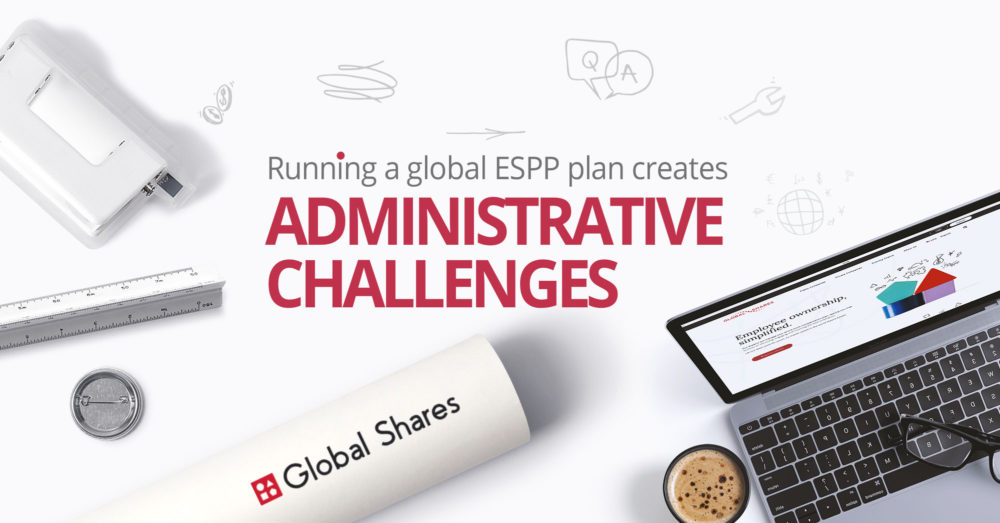There are few better ways to engage and motivate a workforce than to implement a well thought out global ESPP. This is true whether your business is based in a single country or you maintain a presence in multiple locations around the globe. Whatever the size of the enterprise, employees with an ownership stake are incentivized to give their best efforts, because when the company they work for thrives, they too will benefit in a way that is tangible to them.
While this core truism applies to companies large or small, the bigger your business and the more territories you intend to introduce your global share ownership plan in, the more time and thought you will need to put in both at the outset and throughout the process. The administration challenges associated with cross-border ESPPs can be immense, while missteps can prove costly and are therefore best avoided. So, with that in mind, taking the time to do your research and all the necessary preparation work is key.
There is no shortcut available here. It is detailed work that requires time, attention to detail, and the experience and expertise to know what you need to look for. If you put in the necessary time and effort, you will emerge from the process with a full understanding of the various regulatory and admin-related obligations that operating an ESPP in different jurisdictions may require of you.
With that in mind, here we present a guide to some of the main points you need to be aware of and plan for as you work through the process of introducing and then administering global share equity.
Don’t forget the core essentials
While our primary focus here is on admin-related matters, it is important to note that even before you reach that point, there are certain key elements in the process that must be fully addressed.
1. Figure out what you want to achieve
Among those points is to be 100% clear at the outset on what you want to achieve with your global share equity plan (e.g., promote engagement, encourage retention, deliver a reward). When you know what you want from your ESPP, you then know what success will ultimately look like. This, in turn, will influence the final design of the plan and how it operates.
2. Know your budget
Another important early box to tick relates to budget. You need to make sure that you either a) have the budget to implement what you have in mind or b) tweak the design if your budget proves to be lower than you initially envisaged. It would be foolhardy in the extreme to press ahead with ambitious plans if the necessary budget to cover the awarding of shares, administration of the plan, and ensuring ongoing legal compliance is not in place. To attempt to do so would be to guarantee failure.
3. Decide your target population
Also, you need to make an early decision on your target population. Who do you want to include in the plan? Are you looking to reward senior executives or do you want to introduce a more broad-based ESPP? If you are active in multiple countries, do you want to introduce the plan in all countries or limit it to territories where you have a larger presence?
All these points must be fully teased out before you proceed, but once you have clarified the above, then you will be able to move on and begin to address the issues that may come up when looking to introduce an ESPP across multiple countries.
At that point, you will need to tease out how all the following considerations may impact upon your intentions
4. Plan Design
When designing a global ESPP, you will need to ask and answer a number of questions. Do you want the plan to have the same rules and benefits in all countries? If specific tax advantages are available in certain countries, will you want to modify your design to ensure that participants in those territories can benefit? If so, will the accompanying administration obligations create an impractical burden? All these questions and more must be explored.
In general, you need to think about the practicalities of running an ESPP across multiple jurisdictions. You might want to go with a single plan for all participants in every country, but that may prove to be an admin nightmare, given the different rules and regulations in place in Country A versus Country B (not to mention Country C). Depending upon the design you have in mind, the cross-border element may prove to be more or less problematic. You might end up deciding to go with a single plan, but with leeway built in to allow for local adjustments to be made as necessary. Alternatively, you could decide to go with one plan for your main country of incorporation and then another plan – again, perhaps with the customizable element – for all other countries.
There is no single way to go about it, no definitive “right” way, but there will be a best way for you, arising from how what you want to do matches up with the admin and regulatory realities of cross-border ESPPs. Your obligation to yourself, your employees, and your company as a whole is to find what that best way is and then move forward.
5. Managing Eligible Participants
As you can no doubt imagine, with a global ESPP one of the key challenges will be the ongoing management of plan participants. So, you must give active consideration to what system you will use to do so. For example, do you have a global personnel system or will you instead be relying on the systems of local operations in the different jurisdictions? One approach isn’t necessarily going to be better than another, but, again, the key is to be clear on the answers to such questions as early as possible in the process.
6. Understanding Regulatory Requirements
We can’t over-state the importance of checking the relevant regulations governing share plans in all relevant countries. Regulations will vary from region to region, and so you most certainly should not make the mistake of assuming that the rules in one country will automatically carry over into another. For example, the regulatory regime surrounding financial services can be more restrictive in some parts of the world than others, and certain regions, for example, Africa, Asia, and Central America, can be complicated to navigate.
The most important thing to appreciate on this point is that you need to be clear on how the rules vary from region to region and respond accordingly.

7. Participant Contributions
There are also practical considerations to be borne in mind around participant contributions. For example, laws in some countries may not allow for payroll deductions if that money is moving out of the country. There are ways around this, but, in the first instance, you need to know that the issue may arise. On this point, a common solution is for affected participants to provide a separate authorization form to local authorities in order to facilitate whatever deductions are required in line with the terms of the plan.
8. Foreign Exchange Rates
Foreign exchange rates can represent a special challenge for global ESPPs. You will need to have a clear policy on what rates will be used for:
- Converting contributions
- Converting refunds or purchase residuals (a balance that may be used to contribute towards a subsequent purchase)
- Calculating any taxable income
- Internal plan accounting / financial reporting
9. Taxation
At the risk of stating the obvious, you’ve got to understand the tax implications of your ESPP wherever participants are based. Errors on this front can create serious headaches, and may leave some of your employees hit with an unexpected tax bill. This is important no matter what the plan, but is arguably an even bigger issue with an all-employee ESPP, where some of the participants will most likely be relatively unfamiliar with holding shares and simply might not be able to afford a surprise tax liability.
10. Effective Communications
Even if you have come up with the best share plan in the world, if you do not sell it effectively to your target audience – your eligible employees – then it will not be a success. Against this backdrop, developing an effective communications strategy is vitally important.
There is no one-size-fits-all approach here. The best communications strategy for you will be one that is designed with your employees in mind, one that will give them the key information on what is being proposed in the best format for them.
Any modern communications strategy will likely be multimedia in nature. There may be a blend or selection of online presentations, town hall meetings, email communications, postering, and talks on factory floors. Again, it depends upon what is most likely to reach your employees. That is the key point. The communications campaign must be designed first and foremost with them in mind.
This list represents merely a selection of the points you will need to investigate if you are considering launching a global ESPP. The prospect of going down this path may seem daunting if you haven’t done so before. That is why it is worth considering reaching out to specialists who can work with you on the journey – specialists like Global Shares.











